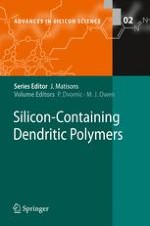2009 | OriginalPaper | Buchkapitel
Polysiloxane and Siloxane-Based Dendrimers
verfasst von : Aziz Muzafarov, Evgenij Rebrov
Erschienen in: Silicon-Containing Dendritic Polymers
Verlag: Springer Netherlands
Aktivieren Sie unsere intelligente Suche, um passende Fachinhalte oder Patente zu finden.
Wählen Sie Textabschnitte aus um mit Künstlicher Intelligenz passenden Patente zu finden. powered by
Markieren Sie Textabschnitte, um KI-gestützt weitere passende Inhalte zu finden. powered by
Three different original protocols for the synthesis of siloxane dendrimers have been described. However, after appearing in the literature at much the same time they did not result in any follow-up, unlike many other strategies proposed simultaneously or even later. To appreciate the suddenness of the introduction of siloxane dendrimers and the reasons for their subsequent neglect we need to make an excursion into orga-nosiloxane chemistry. Silicones are based on a relatively small number of starting functional monomers. Moreover, their combination into new structures is restricted by the reversibility of most reactions and as a consequence by the statistical character of the main methods for the synthesis of siloxane polymers [1–3]. Although the existence of some selectivity results in the formation of useful polycyclics, the possibilities of structural control of linear and especially of branched oligomers and polymers are seriously limited. The nonequilibrium polymerization of strained cyclosiloxanes [4] is a rare exception to this rule which emphasizes the hopelessness of attempts to overcome the “statistical ill fate” that haunts the siloxane structures. All efforts to apply heterofunctional processes to achieve structural diversity are limited by this specificity of the siloxane bond and by a scanty number of appropriate reagents.
Because of this, it is not surprising that after the discovery of sodiumoxyorganoalkoxy-silanes, compounds unique in their synthetic versatility and often called Rebrov's salts [5], the branched functional oligomers and acyclic methylsilsesquioxanes came into the focus of our research attention. Furthermore, most of the oligomers obtained using this approach became the first generations of the corresponding dendrimers, but only after the finding of an appropriate method for quantitative transformation of alkoxy groups into the chlorosilyl ones, and a way to reiteratively use them in pairs did it become evident that possibilities of the new approach for dendrimer synthesis were enormous (see Chapter 1). By that time, dendrimers had become well known in the field of organic polymers, largely due to the efforts of D. Tomalia [6, 7].
